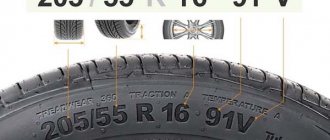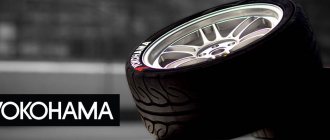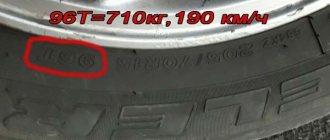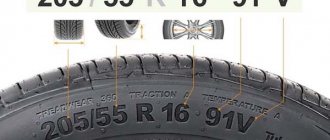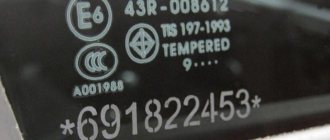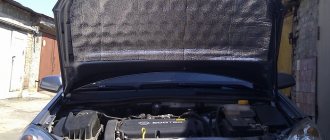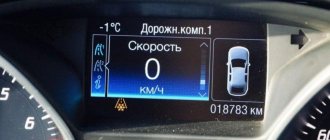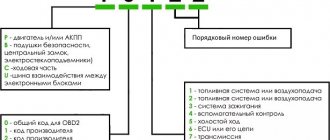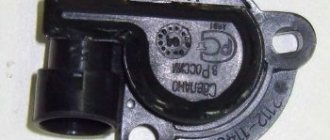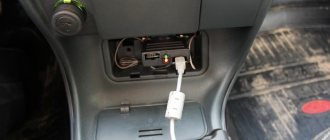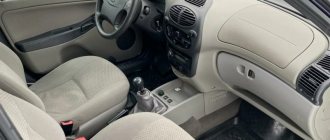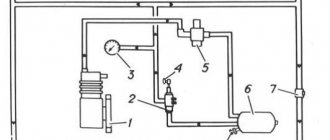Are you looking for what tire markings mean and what their designations mean? In the article you will learn what the numbers and letters of car tire markings mean and a complete explanation of the remaining symbols on car tires for 2022.
R13 means the diameter of the rim, 155 is the width of the tire in millimeters, 70, in turn, means the profile, that is, the height of the rubber. This is a percentage of the tire width, i.e. 155 mm * 70% = 108.5 mm.
Tire markings - interpretation for passenger cars
At the moment, metric tire markings are used, which we will consider using the example of the P 205/65R16 91H tire marking, the decoding will be as follows:
- P - optional index indicating the purpose of the bus
- 205 – width of the tire profile (i.e. the contour of the tire in the radial plane of the wheel), indicated in millimeters
- 65 - the ratio of the height of the tire profile to its width, indicated as a percentage
- R - letter index indicating the type of tire
- 16 - tire mounting diameter corresponding to the diameter of the rim of the car, indicated in inches
- 91 - load index
- H - speed index
Helpful information
The information indicated on tires is very useful for every car owner. The first thing that catches your eye is the name of the manufacturer and brand of the product. Next come large numbers, for example, 175/65/R14 , which mean:
- tire width - 175 millimeters;
- percentage ratio of width to height - 65;
- the internal diameter is R14, which is expressed in inches.
Next you can see the numbers indicating the load factor; it varies from 80 to 115 and above.
This parameter indicates what loads the product can withstand. For example, tires with index 99 are intended for cars up to three tons. If the number is lower, the wheels are intended for a vehicle with a lower load, while the number above is for vehicles with a higher load.
Tires for summer and winter have different designations, for example, on winter tires you can often see the letters M + S, which means that the tires will work well on snowy and muddy roads.
Full explanation of tire markings
Become familiar with all the markings on car tires used by tire manufacturers. Find out how to find out the size and date of manufacture of tires, what are the load and speed ratings, and what is a tire with the M+S designation? See where you can find information about protective rims. We have dispelled all doubts related to the markings on the tire.
Correct reading of the markings ensures the best choice of tires and their subsequent trouble-free operation. In this article, we will clearly explain the meaning of the mysterious symbols you may find on tires.
Model and tread type
When choosing tires, the requirements of a particular car manufacturer should always be taken into account. They can be very different for different brands, models and modifications of cars, so neglecting them can lead not only to accelerated wear of the tires themselves and other vehicle parts, but also to a decrease in the level of safety on the road due to deterioration in handling.
Separation by tread type:
- semi-sports and sports;
- road and urban;
- universal and off-road.
Tires are available without a pattern, which allows you to provide an optimal level of grip on smooth and dry road surfaces, and rain tires, which allow you to move safely and comfortably on wet surfaces. A striking example is the Michelin brand, which produces different lines with the names Pilot Sport, Pilot Power, Pilot City, Macadam and Bopper. All models have separate design features and rubber composition.
The most common markings on tires are:
- Tire size
- Speed index
- Load Index
- 3PMSF
- M+S
- Protective Edge
- Tire reinforced
- Date and place of production
- Asymmetrical tire
- Directional bus
All tire markings (in alphabetical order): # B C D E FG N IJKLMNOPRSTUVWXYZ
Additional information related to tire markings:
- Tire labels
- How to distinguish winter tires from summer and all-season tires?
- UTQG marking (TEMPERATURE, EQUIPMENT, TRACTION)
Tire seasonality
The marking of passenger tires according to seasonality usually looks like this:
- Snowflake inside a schematic piece of ice. Marks winter tires that have a deeper tread (8 - 10 mm), soft rubber and a different working surface pattern.
- Pictogram "sun". Designates summer tires that do not melt at high temperatures (+25 ... +40 °C), have a large contact patch with the surface and special grooves for draining water.
- Аllseason or Allweather means that the tire is all-season. Such rubber is used at average temperatures in the range from -7 to +25 °C.
On tires you can often find the designation S+M, which stands for SnowandMud (snow and mud). These tires are suitable for severe weather conditions. There is also a special anti-rain rubber, on the sidewall of which a drop of water or an umbrella will be drawn.
Explanation of tire marking designation
- Tire width in millimeters
- Profile height as a percentage of width
- Letter designating the tire design (R - radial, D - diagonal, B - belt
- Rim diameter in inches
- Load index (coefficient) that determines the maximum load on the tire at which it will not collapse
- Speed index, which determines the maximum speed for which the tire is designed
- The presence of the word REINFORCED or the letter C indicates a reinforced tire carcass
- Manufacturer country
- Indication of the side for asymmetrical tires, OUTSIDE is the outer side of the tire, INSIDE is its inner side
- Adaptability of the tire to special operating conditions, M&S (M+S) - mud and snow, AS (All Season) - all-weather, AW (Any Weather) - any weather, Aquatred, Aquacontact or an umbrella pictogram - special rain tires, Pictogram in in the form of a snowflake - tires for winter, lack of any markings - tires for use only in the warm season
- Certification mark
- TUBELESS - tubeless tire, TUBE TYPE or no inscription - tire with a tube
- Tire design details
- Manufacturer's company name or logo
- Tire model
- Maximum load and pressure
Additional markings
Tires often have additional markings, which also need to be properly deciphered. It complicates the overall process somewhat. This example includes 3 or 4 digits that reflect the week and year of manufacture. Sometimes you can find an individual tire number, that is, a series. And a number of markings may, at first glance, be specific. After all, some of the tires can be installed either on the rear wheels or on the front:
- F, Front Wheel or Front Wheel Only is designed to fit on the front wheels;
- Rear Wheel means the ability to install on rear wheels;
- Rotation refers to the direction of rotation and is also important during the installation process of a car tire.
Rubber with a symmetrical pattern allows the tire to be installed on either side. And asymmetrical tires must be installed according to a strict principle.
Often, product manufacturers provide additional instructions on testing and operational approval for use in certain countries. Most often you can find a transport approval from the US Department of Transportation (Department of Transportation) or E1 - tests performed in Germany. However, in the second case, the serial number and the official approval number are often indicated.
Author: Artem Sapegin (automotive expert, author of numerous articles)
What do the symbols on the bus mean?
195 — tire width in millimeters.
50 - the value expressed as a percentage means the ratio of the height of the side of the tire (the place where we found information about the tire size) to the width. In this case, the value "50" means 50 percent of 195 mm or 97.5 mm.
R - radial design, a type of tire construction.
15 - the diameter of the seat, which is also the diameter of the rim, given in inches. 82 T is a load index with a value of 82 and a T class speed index (you can read the indices below).
C - designation of the delivery tire.
Speed index. The speed index is a sign that tells you the maximum speed you can drive on a given tire. You will find it on the side of the tire, at the end of the size sign. ATTENTION! For winter tires, you can use a lower speed than the manufacturer's recommended speed.
Colored marks.
Tires can have not only inscriptions and pictograms, but also colored markings. The main ones are:
- a yellow triangle, square or circle is the lightest place on the tire, usually near the nipple (combined with the heaviest place on the rim when mounting tires for better balancing);
- a red triangle, square or circle is the place where the maximum force heterogeneity is located; every tire has it and is determined by the production technology (during tire fitting, the red mark is aligned with the white mark on the rim).
You may also find white stamps and colored stripes, but they are not important when using tires.
Load Index
The load index is another important mark on the tire. Indicates the maximum permissible load on one tire when driving at maximum speed. It is strictly forbidden to use tires with a lower load rating than recommended for a specific vehicle model. For example, a tire with a load index of 91 can be subjected to a maximum load of 615 kg. If you multiply this value by the number of tires on the car, you will get a result that is slightly higher than your vehicle's maximum fully loaded gross weight (you can read this in the F1 field on your registration certificate).
The most common load indicators:
Speed limit of car tires
The correspondence to the speed designation of its indicators can be found in the table:
| Maximum speed (km/h) | Speed index |
| 120 | L |
| 130 | M |
| 140 | N |
| 150 | R |
| 160 | Q |
| 170 | R |
| 180 | S |
| 190 | T |
| 200 | U |
| 210 | N |
| 240 | V |
| 270 | W |
| 300 | Y |
| More than 300 | Z |
The marking indicates what the highest speed can be achieved on certain tires. It looks like Latin letters and is indicated on the side of the tire.
All tire markings (in alphabetical order)
3PMSF is a symbol confirming winter tire properties found on winter tires and all-season tires.
3PMSF symbol on the bus. B Designation
BasePen - The tire is electrostatically grounded (a groove running through the center of the tread contains a silica mixture that dissipates electrical charges).
BLT - (Raised Black Letters) black and raised letters. Designation BSW - (black sidewall) inscriptions on the tire in black.
C - COLD marking - this is information that the pressure is measured on cold tires. You will find the tire's production date at the end of the DOT number.
D - DOT - (Department of Transportation) tire property designation meets all safety standards of the US Department of Transportation. The mark is adjacent to the 12-digit identification code or serial number of the tire. At the end of the DOT number is the date of manufacture of the tire. Tire release date—indicated at the end of the DOT number. The picture shows the Matador tire released in week 42 of 2008. Tire age information is also on the side. Look for a tire identification number that begins with the letters DOT. This is a string of 7 to 12 characters long, informing about the entire batch of tires produced at this plant. The last four digits of this code (most often located on the border) contain information about the tire production date. For example, 4208 - the first two digits are the week of production, the second two are the abbreviation of the year, that is, the tire was released in the 42nd week of 2008. Designation DSST - Dunlop RunFlat tire.
E - Designation ECE, e, E - abbreviation for Economic Commission for Europe means European approval. EMT (Extended Mobility Tire) tires allow you to drive even after the pressure drops to zero.
F - Designation FP - (Fringe Protector) or RFP (Rimb Fringe Protector) tire with rim protection. Dunlop uses the symbol MFS. The FR marking is a tire with a protrusion to protect the rim from mechanical damage. Most often found in tires with a profile of 55 and below. This depends on the specific manufacturer, as well as the type and size of the tires. Examples of sizes where ribbed tires are the most common are: 205/45R16, 195/50R15, 205/55R16 (there are exceptions). Less common for sizes: 145/65R15, 235/70R16 (in SUVs). FR markings do not appear on tire sidewalls.
and - Signs outside and inside - symbols used in asymmetrical tires, indicate which side of the tire should be installed inside, in the direction: towards the car, towards the hub with the rim. The inside side of this tire should not be visible from the outside of the vehicle.
J - Designation JLB - (Jointless Band) endless tape made of nylon.
L - Marking LI - (load index) indicator that determines the maximum load capacity of the tire.
LT - (Light Truck) marking indicating that the tire is intended for 4x4 vehicles and light trucks (used in the USA). This happens down to the tire size.
M - Marking MAX - maximum or maximum tire pressure.
The M+S (Mud and Snow) designation is mud and snow used as a designation for winter, all-season and SUV/SUV tires; often found even on tires from Europe; This designation is only a declaration of the manufacturer, it is not an official symbol confirming the winter properties of the tire.
The M+S marking is found not only on winter and all-season tires.
Marking MFS - (Maximum Flange Shield) - rim protection; Some winter tires have a protective edge on the rim, called a wheel tread. The purpose of the rim is to protect the edge of the rim from mechanical damage that may occur, for example, when approaching a curb or getting caught in an object. There are different names for rantings, depending on the tire manufacturer.
The most common non-MFS are: RFP (Rim Fringe Protector) marking, FP (Fringe Protector) marking - rim protection, FR (Felgen Ripen) marking - rim protector.
o - Designation OWL - (Circled in white letters) in white letters. EXTERNAL SYMBOL - used on asymmetrical tires, denotes the method of tire assembly. Outside means that the side of the tire with this mark must be visible from the outside of the vehicle after the wheel is installed on the rim.
P - Designation P - (Passanger) symbol is placed in front of the tire size. This means that the tire is designed for passenger cars (used in the USA). The PAX marking is a zero-pressure Michelin tire with a stable inner ring. Designation PSP-Beta - the tire has a design that is characterized by overlaps to reduce noise levels.
R - Marking R - (radial) radial tire.
RBL markings are (recessed black letters) concave black letters.
RETREAD marking - retreaded tire.
The RF designation is an abbreviation for reinforced English; describes a reinforced tire with increased load-bearing capacity (load-bearing capacity). It has the same meaning as for tires with the XL symbol. Other designations for reinforced tires are, for example, EXL, RFD, REF, REINF. RFT - Run Flat Tires, Run Flat tire, used in Bridgestone, Firestone, Pirelli. RIM PROTECTOR marking - the tire has solutions to protect the rim from damage. The rim protector prevents damage to the rim due to impacts or abrasions, such as on a curb.
ROF is a "Run On Flat" symbol used by Goodyear and Dunlop to mark tires that allow tires to continue driving after tire failure without air pressure inside. ROTATION marking - always with an arrow, indicates the rolling direction of the tire used in directional tires. The ROTATION indicator informs you about the correct way to install the directional bus.
RSC Marking - Abbreviation for Run Flat System Component. This occurs on tires compatible with the run flat system used in BMW vehicles. Designation RWL - (Raised White Lettering) raised white letters.
S - Designation SST - (Self Supporting Technology = RunOnFlat) a tire that allows you to continue driving even after a breakdown, when the pressure inside is zero. SI - (Speed Index) designation indicating the upper limit of the permissible speed of use. T Designation TL - (tubeless tire) tubeless tire. Designation TT - (tube tire type) dętkowa tires. The TWI designation is an abbreviation for the English Treadwear Indicator. The TWI marking is found in six places around the tire circumference (in the form of ridges in the tread grooves) and indicates the permissible wear limit of the tread pattern. When the tread wears to the TWI level, it means the tire has reached the legal depth of 1.6mm. Then you should consider replacing the tire.
U - Designation ULW - the tire has a construction that uses aramid cords.
B - Designation VR or ZR - speed indicators are woven into the tire size. The VR and ZR markings indicate that the tire can be used with full load capacity up to the specified speeds: VR - up to 210 km/h, ZR - up to 240 km/h. For example: 225/45 ZR17 91 W means that the tire can be used with full load up to 240 km/h, and the maximum speed for this tire is 270 km/h.
X - Mark XL - (Extra Load = RF) tire with reinforced structure and increased load capacity. Reinforced tires have a special design that allows them to be used with greater loads.
c - Designation ZP - Zero Pressure, Michelin tire for descent.
Additional information related to tire markings
Tire label From November 1, 2012, on every tire manufactured after June 30, 2012, a label must be found informing about the main characteristics of the tire. It has 3 parameters: rolling resistance, which affects fuel combustion and CO2 emissions, wet grip, which gives an idea of the overall level of safety provided by the tire, external noise level, which affects the overall road noise level.
The labels give a general idea of the tire's characteristics, but do not contain many important parameters, such as the basic characteristics of winter tires. Don't completely trust the label when making a tire purchasing decision.
Country and manufacturing company
All manufacturers put their logo and name on the side of the wheel.
Many companies have factories in different countries, and the quality of their products can vary significantly. For example, Japanese Bridgestone tires can be produced in Italy, France, Finland, Thailand, Malaysia and many other countries.
Some tires have the inscription “Made in...”, but if it is not there, you can find out in which country the tires were produced by the DOT code. Thanks to it, you can also find out the series, plant and date of manufacture of a specific item.
The country of origin is encrypted in the form of 2 letters, which are located immediately after the abbreviation DOT. For example:
Each manufacturer has its own system for naming its factories. This is how the famous Bridgestone brand puts such codes on board
- 1D; EH; EJ; EK; EL; EM; EN; EP; H4 – country of origin: Japan;
- 0B; 0W; 1C; 2C; 2M; 3M; 4D; 5D; 7B; 8B; D2; HY; VA; VD; VE; W1; W2 – USA;
- 1U – China;
- 1V,A7 – Thailand;
- 3Y,7G, E2–Poland;
- 5T, 6T – Brazil;
- VN, 9B – Canada;
- A8 – Indonesia;
- J2 – Singapore;
- L5 – Türkiye;
- LH–Australia.
How to distinguish a winter tire from a summer tire?
Winter tires have M+S (Mud+Snow, Mud+Snow) on the side of the tire and a three peaks symbol with a snowflake inside. Sometimes there is no M + S sign on the tire, but there is a symbol with a snowflake - this also means. that the tire is intended for the winter season.
It is a little more difficult to distinguish a winter tire from a year-round tire. Tires of this type, found in Europe, are usually identified by a snowflake with an M+S symbol. The differences are visible in the tread. In the case of an all-season tire, it has fewer cuts and grooves than a typical winter tire, but more than a summer tire. Some models have an asymmetrical tread pattern: half is responsible for summer performance (summer tread with fewer bars), and the other for winter performance.
All-season tire model names often include phrases that indicate good performance throughout the year, such as "All Season", "Quatrac", "Quadraxer", "4 Seasons", "All Weather", etc. Some manufacturers also have your own year-round tires - these are usually symbols that allow you to easily identify the type of tire you're dealing with.
Watch out for tires that have the M+S designation without the snowflake. These may be products imported from the US, where most tires carry the M+S designation, but have nothing to do with all-season or winter products.
In European realities, all-season tires are similar to winter tires, so they most often have the symbol of a mountain with a snowflake. The M+S marking may also appear on 4x4/SUV tires regardless of their season. In conclusion, the mountain symbol with a snowflake means that the tire will perform well in typical winter conditions. UTQG marking The UTQG marking (Uniform Tire Quality Grading) applies mainly to passenger tires from the US market, but they can also be found in Europe (this model may fall into both markets). They are not officially used on our continent, so manufacturers and sellers do not report their meaning and cost for these models. This type of marking can be found on the sidewall of the tire in the form of subtitles with specific meanings: TREADWEAR - abrasion resistance of the tread, TRACTION - tire grip on wet roads, TEMPERATURE - tire resistance to overheating. tread wear.
To explain this concept well, the definition of a comparison bus should be mentioned first. This is a standardized model whose parameters correspond to the TREADWEAR 100 index. TREADWEAR values can appear on tires for sale in multiples of 20 (60 - 80 - 100 - 120 - ... 200 ... 800).
How are they distributed? The test is conducted under controlled conditions on a designated route of 6,400 miles or approximately 10,300 kilometers around Goodfellow Air Force Base, San Angelo, Texas.
The tested tires are installed on a specially prepared car together with tires with an index of 100, and then the consumption is compared. Its level is measured every 800 miles (1,287 km). Based on the measurement results, tires are given an index, such as 60, 100, 200 or 400. If a tire receives an index of 60, its theoretical durability is 60% of the comparison tire (index 100).
As a result, a tire with an index of 60 will wear out almost 2 times faster than a tire with an index of 100. In turn, a tire that receives an index of 200 will wear out 2 times slower than a comparison tire, and 2 times faster than a tire with an index of 200. index 400. A model with an index of 400 will be 4 times more durable than a comparative product (with an index of 100).
TRACTION Adhesion under UTQG marking is expressed by letters. The highest rating is AA, followed by A and B, and the lowest is C. This rating gives the driver information about the tire's ability to stop the car on wet roads.
The TRACTION parameter is determined on an asphalt or concrete path under strictly defined conditions. The test car accelerates to a speed of 65 km/h, then brakes. During the test, the vehicle's ABS system is disabled. In Europe, the lowest allowed TRACTION value is A. If someone prefers a dynamic and aggressive driving style, it is worth looking for tires with the AA index. Indices B and C are acceptable only in American conditions, and in Europe it is better not to buy such tires.
It should also be noted that the TRACTION marking does not indicate dry adhesion, flexure or hydroplaning resistance.
TEMPERATURE
The last of the UTQG designations is TEMPERATURE, which determines the tire's resistance to overheating, that is, the temperature created while driving. When driving at high speeds, the tire becomes very hot, which can shorten its life. Laboratory tests are carried out to isolate the index (possibly A, B and C, where A is the best value). Resistance to overheating is very strongly related to the speed index. Therefore, for the A mark, a 30-minute test at 115 mph (185 km/h) must be completed to obtain the B mark, at a 30-minute test speed of 100 mph (160 km/h) for both the tire and index C The tire must pass the test at 85 mph.
TRACTION (adhesion) and TEMPERATURE (overheating) markings in Europe must be at least A. TREADWEAR (wear resistance) will help you choose tires with a longer service life. If you want to take these signs into account, remember that the difference between tires with an index of 200 and 400 will be significant. However, UTQG markings should be considered as an overview only. There is no need to use them in Europe and the values are determined based on North American conditions.
Tire markings must be applied to the following tire manufacturers:
Amtel, Belshina, Barum, Bridgestone, Continental, Cooper, Cordiant, Dayton, Debica, Goodyear, Dunlop, Falken, Firestone, Fulda, General, Gislaved, Hankook, Kama, Kelly, Kleber, Kormoran, Kumho, Marshal, Matador, Maxxis, Michelin, Nitto, Nokian, Pirelli, Sava, Semperit, Tigar, Triangle, Toyo, Uniroyal, Yokohama. This tire marking is valid from 2022.
About the manufacturers
In fact, when choosing tires, many car enthusiasts rely on the brands that manufacture the products. We list the most famous brands:
- Michelin;
- Dunlop;
- Pirelli
- Bridgestone;
- Heidenau;
- Metzeler;
- IRC;
- Continental;
- etc.
There is a popular belief that brand fame affects the quality of the product. But in practice, experienced motorists will say that this is not entirely true. Unfortunately, this is primarily due to the fact that European brands tend to make tires in underdeveloped countries. Typically, these include Taiwan and Serbia. Therefore, quality indicators will differ from the initial indicators that are typical for production in Europe itself.
Additionally, it is worth listing less popular brands, but at the same time periodically found on our market:
- Sava;
- Mitas;
- Cheng Shin;
- Kenda;
- AvonShinco;
- Duro;
- Maxxis;
- and etc.
It is also worth noting the seasonality of tires. They can be:
- Summer;
- Winter;
- All-season.
Tire sizes. How to find out the tire profile?
Car tires have their own diameter, width and height. The seat diameter is measured in inches (equal to 25.4 mm) and must correspond to the size of the wheel rims. On board it is designated by numbers: 15, 17, 20, etc.
Size designation
You can select the appropriate sizes using the table:
A profile refers to the 2 numbers on a tire, for example 225/40. The first means the width of the tire, and the second its height as a percentage. This means that with a width of 225 mm, the height will be 40%, that is, 90 mm.
Seasonal designations
It is important to know that a single system is used for marking car tires. Therefore, regardless of the manufacturer, the decoding of typical elements will be the same.
The choice of tires for the season brings a lot of excitement to car owners. Moreover, the marking of winter tires has several variations and it is extremely difficult to decide on the right one. Up to 90% of buyers are confident that tire markings such as M+S characterize the winter season. They are not right in everything, but they are not wrong in everything either. After all, the typical “m + s” tire marking is not so simple.
First of all, you need to know that the letters indicated are abbreviations for the English words “mud and snow.” That is, in conditions when there is snow on the roads, slushy and dirty, the tires will perform excellently.
. In the language of specialists, this means that:
- the rubber is soft and will not stick;
- such an unpleasant phenomenon as aquaplaning is excluded;
- increased level of rolling resistance.
According to the tire labeling rules, such a product can be used in winter conditions. But in European winter conditions.
Since this designation was developed precisely by European brands, determined to fight on the roads mainly with slush, dirt and snow porridge during the cold period. And to a temperature of minus seven Celsius. In Russian realities, such conditions are created in the off-season, so it’s not worth taking risks and using such tires in cold weather.
Not everyone knows that marking tires with the letters M and S can be a deception. This is possible due to the fact that the combination of symbols is not a registered trademark. This means that its placement is not regulated by law, which is what small companies take advantage of - they place symbols without technical grounds for this. Such tires can fail even in the off-season.
Winter markings on car wheels look like a mountain with a snowflake. Some brands put it after the M and S symbols, but this should not confuse drivers.
If a snowflake is stamped on the tires, then it is definitely suitable for harsh winters and is distinguished by the following characteristics:
- good behavior on icy and snowy roads;
- overcoming the permissible threshold of the grip index on snow;
- maintaining its properties at temperatures below -40 Celsius
Studded tires are additionally marked with letter designations. They reflect the shape of the spike and the material from which it is made:
- AD – use of aluminum;
- SD – presence of a carbide core;
- DD – combination of a rectangular core and diamond edges;
- OD – oval core;
- MD – plastic as the main material + hard alloy core.
Some car owners prefer to drive an all-season car.
The marking of all-season tires has several variations - AS, AGT, AW. All these abbreviations mean rubber that can be used all year round. But still, do not forget that “all-season” is not suitable for active everyday use.
In the summer heat, it quickly wears out and loses its rigidity. And in winter, when crossing zero temperatures, it loses elasticity and adhesion to the road surface. Therefore, such tires can be purchased by those who travel occasionally and do not spend more than 2-3 hours behind the wheel 1-2 times a week.
When choosing a summer kit, drivers are advised to pay attention to the following inscriptions:
- Aquatred;
- Aquacontact;
- Rain;
- Water;
- Aqua.
Or an image of an umbrella. The listed words and picture mean that the wheels drain water well and do not lose traction during heavy rainfalls.
It is worth considering that a number of brands indicate seasonality only with infographics. They put a snowflake on winter options, the sun on summer ones, and several images at once for “all seasons”.
